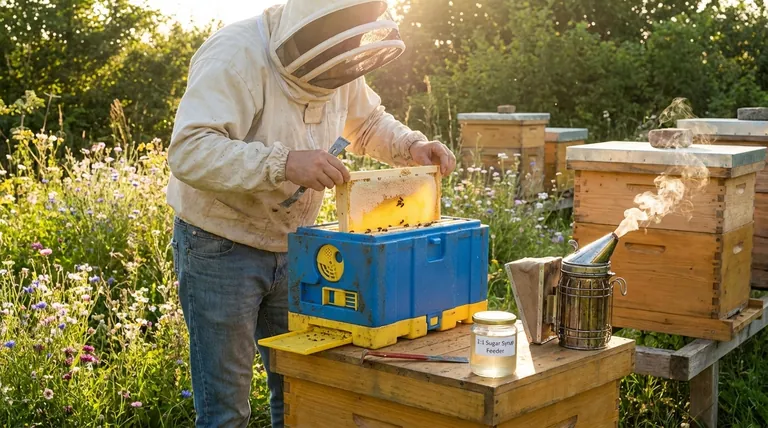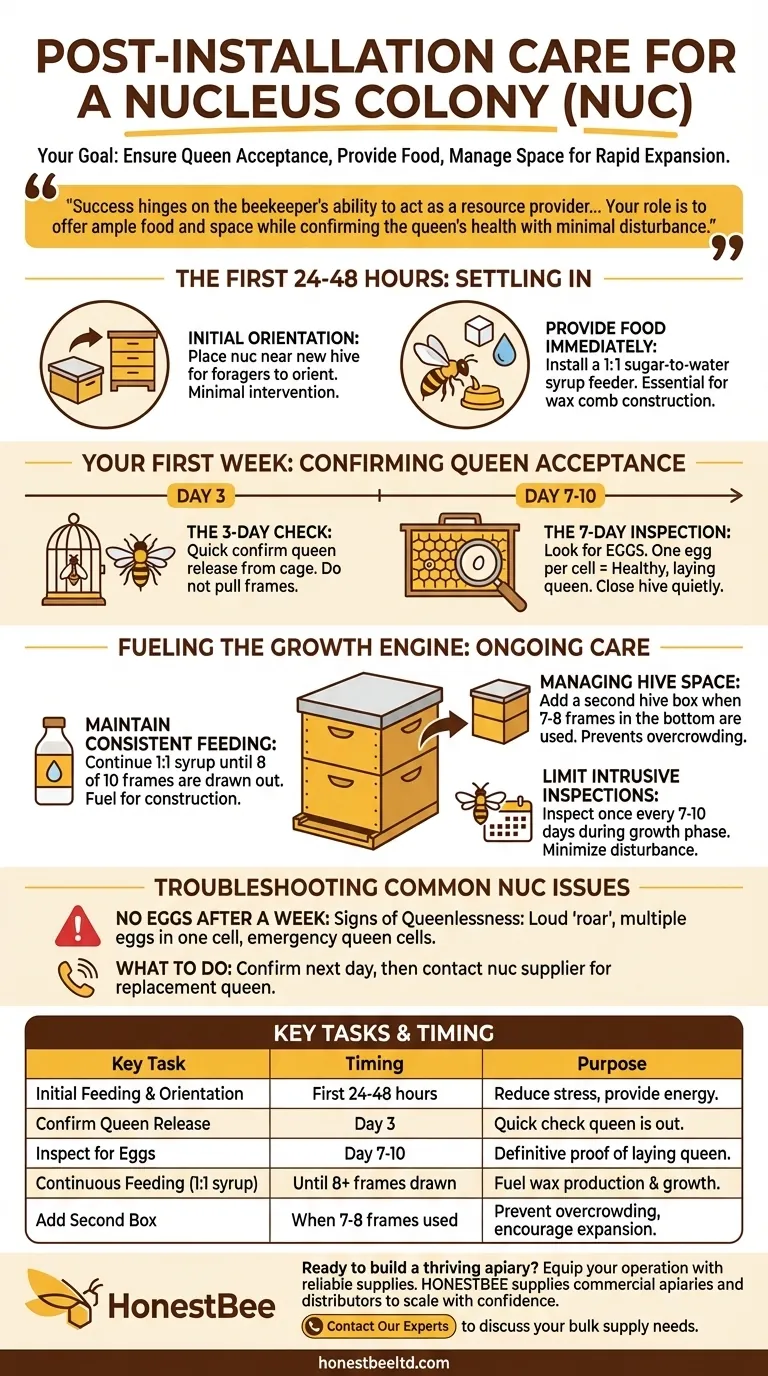Your primary goal after installing a nucleus colony is to ensure the queen is accepted and laying, provide consistent food to fuel comb construction, and manage space to accommodate the colony's rapid expansion. This initial period of support is critical for helping the small nuc population establish itself in the new, larger hive.
The success of a new nucleus colony hinges on the beekeeper's ability to act as a resource provider, not an intruder. Your role is to offer ample food and space while confirming the queen's health with minimal disturbance, setting the stage for explosive growth.

The First 24-48 Hours: Settling In
The moments immediately following installation are about reducing stress and allowing the bees to orient. Your intervention should be minimal but precise.
Initial Orientation
Before transferring the frames, it's wise to place the sealed nuc box on top of or beside the new hive for a few hours. This allows the forager bees to orient to their new location, reducing the number of bees that get lost after being moved.
Provide Food Immediately
A nuc has a small workforce and limited stores. They need immediate and abundant energy to begin the massive task of drawing out new wax comb.
Install a feeder with a 1:1 sugar-to-water syrup solution as soon as you have transferred the frames. This is not optional; it is the fuel for all new construction.
Your First Week: Confirming Queen Acceptance
The most critical task in the first week is to verify that the colony has a healthy, accepted, and actively laying queen.
The 3-Day Check
After about three days, perform a very quick check. Your only goal is to see if the queen, if she was in a cage, has been released by the workers.
Do not pull frames or search for the queen herself. Just confirm her release, close the hive, and let the colony settle. This minimizes disturbance while she begins her work.
The 7-Day Inspection: Look for Eggs
One week after installation, it's time for your first full, though brief, inspection. The primary goal is to find proof of a laying queen.
Carefully and gently lift a center frame from the original nuc. Tilt it into the sunlight and look for tiny, rice-like eggs at the bottom of the cells.
What Seeing Eggs Confirms
Finding one egg per cell, standing upright in the center, is the definitive sign of a healthy, accepted queen. You do not need to physically see the queen herself. Once you see eggs, your job is done. Close the hive quietly.
Fueling the Growth Engine: Ongoing Care
With a laying queen confirmed, your focus shifts to supporting the colony's expansion.
Maintain Consistent Feeding
Continue feeding the 1:1 sugar syrup without interruption. A new colony can consume a surprising amount.
The goal is to feed them until they have drawn out comb on at least 8 of the 10 frames in the first hive box. Only then can you consider scaling back.
Managing Hive Space
A nuc will quickly outgrow its initial frames. Once the bees have built out and are using 7 or 8 of the frames in the bottom box, it is time to add a second hive box on top.
Providing this space proactively prevents the colony from becoming "honey bound" and encourages the queen to keep expanding her brood nest.
Limit Intrusive Inspections
While it's tempting to check on them constantly, each inspection sets the colony back. It breaks the propolis seals, disrupts their work, and risks harming the queen.
Limit inspections to once every 7-10 days during this critical growth phase.
Troubleshooting Common Nuc Issues
Sometimes, things don't go according to plan. Knowing the signs of trouble allows you to intervene correctly.
No Eggs After a Week
If you see no eggs or larvae after 7-10 days, the colony may be queenless. The queen may have been damaged during installation, or she may have been rejected.
Signs of Queenlessness
A queenless colony will often have a distinctive, loud "roar" when you open the hive. You may also see multiple eggs in a single cell or the development of emergency queen cells on the face of the comb.
What to Do
If you confirm the colony is queenless, wait another day or two to be absolutely certain, then contact your nuc supplier immediately. They can often provide a replacement queen.
A Checklist for Nuc Success
- If your primary focus is colony survival: Your first and most important task is to confirm you have a laying queen by spotting eggs within 7-10 days.
- If your primary focus is rapid buildup: Provide an uninterrupted supply of 1:1 sugar syrup until the first box is almost completely drawn out with new comb.
- If your primary focus is minimizing stress: Keep your inspections brief, gentle, and purposeful, and avoid the temptation to check on them more than once a week.
Proper care in these first few weeks will transform your small nucleus colony into a powerful, productive, and thriving hive.
Summary Table:
| Key Task | Timing | Purpose |
|---|---|---|
| Initial Feeding & Orientation | First 24-48 hours | Reduce stress, provide energy for comb building. |
| Confirm Queen Release | Day 3 | Quick check to ensure queen is out of cage (if caged). |
| Inspect for Eggs | Day 7-10 | Definitive proof of a healthy, laying queen. |
| Continuous Feeding (1:1 syrup) | Until 8+ frames are drawn | Fuel for wax production and colony growth. |
| Add Second Box | When 7-8 frames are used | Prevent overcrowding, encourage expansion. |
Ready to build a thriving apiary? Equip your operation with the reliable, high-volume supplies needed for successful nuc establishment and beyond. HONESTBEE supplies commercial apiaries and beekeeping equipment distributors with the wholesale-focused equipment and resources to scale with confidence. Contact our experts today to discuss your bulk supply needs and ensure your colonies get the best start.
Visual Guide

Related Products
- 4 Frame Plastic Nuc Boxes for Beekeeping Bee Nuc Box
- HONESTBEE Professional Multi-Functional Hive Tool with Ergonomic Wood Handle
- Multi-Function Plier-Style Frame Grip Hive Tool
- Black Plastic Beetle Barn Hive Beetle Trap for Beehives
- HONESTBEE Professional Long Handled Hive Tool with Precision Cutting Blade
People Also Ask
- How many bees are in a nucleus hive? Get a Head Start with 10,000-15,000 Bees
- How does installing a nuc differ from installing a bee package? A Guide to Starting Your Hive Right
- What should a healthy brood nest in a nuc look like? A Guide to Strong Colony Development
- What are the advantages of choosing a nucleus hive over a package of bees? Get a Head Start with a Pre-Established Colony
- How does colony growth differ between nucs and bee packages? A Guide to Faster Beehive Buildup



















